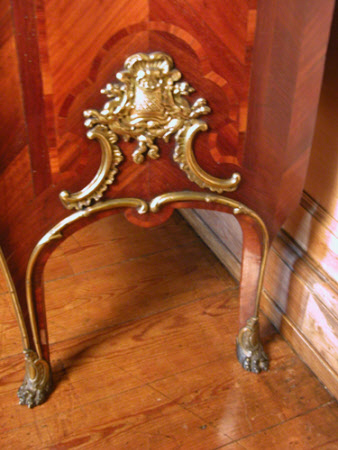Commode
attributed to Charles Cressent (1685 - 1768)
Category
Furniture
Date
1745 - 1750
Materials
Parquetry inlaid bois satine, purplewood and kingwood with ormolu mounts, Breccia Capitolina marble top. Oak construction
Measurements
89.5 x 131.5 x 65.5 cm
Place of origin
Paris
Order this imageCollection
Blickling Hall, Norfolk
NT 354222
Summary
A parquetry inlaid bois satiné, purplewood, kingwood and ormolu mounted bombe commode, attributed to Charles Cressent (1685-1768) Paris, circa 1745. With a shaped and moulded Breccia Capitolina marble top above two long drawers with applied floral and scroll cast ormolu mounts incorporating dragons heads and trailing vines. The sides with further applied mounts. Raised on cabriole legs and cast ormolu lions paw sabot.
Full description
Charles Cressent (1685-1768) came from a family of sculptors and is best known for the impressive sculptural mounts on his pieces. They provide a lively sense of movement on the relatively sobre surfaces of his furniture, which were often, as here, veneered with restrained geometric patterns in bois satiné (a wood related to mahogany), sometimes combined with amaranth (purplewood). In eighteenth-century Paris it was strictly forbidden for members of the guild of cabinet-makers to make their own gilt-bronze mounts. They were supposed to buy them from the guild of casters and guilders. Cressent disregarded this ban, employing metal-workers within his own workshops to execute his own models. He was the subject of complaints from the casters and guilders on several occasions. For a very similar example see V&A collection museum no. 1119:5-1882, which has almost identical mounts and is of an identical size, suggesting it may be the pair to the commode at Blickling. The example at the V&A has had small parts of the ormolu replaced. Cressent's work is regarded as some of the best to come out of Paris during this period. A key artist of the eighteenth century, Cressent played a pivotal role in the birth of the Rococo style in France. See Daniel Alcouffe, Anne Dion-Tenenbaum, Amaury Lefébure, Le mobilier du musée du Louvre, t. 1, Dijon, Editions Faton, pp. 128-129. Alexandre Pradère, Les ébénistes français de Louis XV à la Révolution, Paris, Editions Le chêne, 1989, p. 129. (James Weedon 2016)
Provenance
Part of the Lothian Collection. The hall and contents were bequeathed to the National Trust in 1940 by Philip, 11th Marquess of Lothian (1882-1940). The cabinet was transferred from the Lothian House at Newbattle Abbey, Midlothian in 1936 after the property was gifted to the nation. It came with twenty other items of furniture and paintings which were Lord Lothian's favorite pieces from Newbattle.
Makers and roles
attributed to Charles Cressent (1685 - 1768), maker
References
Daniel Alcouffe, Anne Dion-Tenenbaum and Amaury Lefébure 'Le mobilier du musée du Louvre', pg.128-129 Alexandre Pradère, 'Les ébénistes français de Louis XV à la Révolution', Paris, Editions Le chêne, 1989



